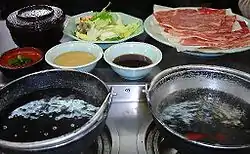Shabu-shabu
Shabu-shabu (Japanese: しゃぶしゃぶ, romanized: shabushabu) is a Japanese nabemono hotpot dish of thinly sliced meat and vegetables boiled in water and served with dipping sauces.[1] The term is onomatopoeic, derived from the sound – "swish swish" – emitted when the ingredients are stirred in the cooking pot.[2] The food is cooked piece by piece by the diner at the table. Shabu-shabu is generally more savory and less sweet than sukiyaki.
 | |
| Type | Hot pot |
|---|---|
| Place of origin | Japan |
| Region or state | Osaka |
| Main ingredients | Meat, vegetables, tofu |
History
Shabu-shabu was invented in Japan in the 20th century with the opening of the restaurant Suehiro in Osaka, where the name was also invented.[2] The president of the restaurant, Chūichi Miyake, registered the name as a trademark in 1952.[2] Shabu-shabu became more and more popular in the Kansai region and in 1955 it was also added to the menu of restaurants in Tokyo and then spread throughout Japan.[3]
There are two believed histories. One is traced back to the Inner Mongolian hot pot known as instant-boiled mutton (Shuàn Yángròu). Because Shabu-shabu is very similar to this dish not only the method but also pot itself.
Another possible history originates from Japanese Mizutaki hot pot which is a popular type of nabemono in Japan. Mizutaki has various ingredients and versions but is always based on dashi or water without additional flavourings.
Compared with other Japanese hot-pot dishes (nabemono) such as well known sukiyaki,[4] Shabu-shabu is infrequently cooked at home in Japan. However, together with sukiyaki, shabu-shabu is a popular dish in many parts of Japan, and also in local Japanese neighborhoods (colloquially called "Little Tokyos") in countries such as the United States and Canada. It is also popular in Taiwan and South Korea.
Preparation
.jpg.webp)
The dish is usually made with thinly sliced beef, but some versions use pork, crab, chicken, lamb, duck, or lobster. Most often, ribeye steak is used, but less tender cuts, such as top sirloin, are also common. A more expensive breed of cattle, such as Wagyu, may also be used. It is usually served with tofu and vegetables, including Chinese cabbage, chrysanthemum leaves, nori (edible seaweed), onions, carrots, and shiitake and enokitake mushrooms. In some places, udon, mochi, or harusame noodles may also be served.
The dish is prepared by submerging a thin slice of meat or a piece of vegetable in a pot of boiling water or dashi (broth) made with konbu (kelp) and stirring it. Normally, the raw meat is dipped into the hot stock for just a few seconds, as the pieces are sliced paper thin so they will cook quickly. Putting all meat into the pot at one time may result in overcooking the meat. Cooked meat and vegetables are usually dipped in ponzu or goma (sesame seed) sauce before eating, and served with a bowl of steamed white rice.
General order to put ingredients into the pot[5]
- "shabu-shabu" some meat (the meat "dashi" will add some depth to the soup)
- add ingredients which need some time to cook such as carrots, shiitake mushrooms, Chinese cabbage, etc.
- add ingredients which are fast to cook such as tofu, green onions, mizuna and Chinese cabbage leaves.
Once the meat/fish and vegetables have been eaten, the soup stock will remain in the pot. The leftover broth from the pot can be customarily combined with rice, ramen or udon and the resulting dish is usually eaten last and called shime in Japan.
The variation with rice is also called zosui.
Sauces and dippings
A variety of sauces can be used to dip the meat and vegetables, including ponzu sauce and sesame sauce. Restaurants usually provide soy sauce, sesame paste, ponzu and several other condiment options, such as spring onions and Japanese pickled carrots, so customers can make the sauce according to their own preferences.
Shabu-shabu variations across Japan
Most commonly meat (beef, pork or chicken) is used for Shabu-shabu but recently there are also increasing variations with vegetables or fish. For the variation with vegetables lettuce or sliced radish can be used. The fish variations are usually made with yellowtail (japanese: buri), amberjack (japanese: Kanpachi) or sea bream (japanese: tai). For some other more rare Shabu-Shabu variations octopus or crabs are used.[6]
When the cooked meat is served cold, it's called "Rei-shabu". Rei-shabu is often sold in convenience stores and supermarkets in Japan.[7]
Tohoku Region: Wakame Shabu-shabu ("Wakame no Shabu-shabu")
Kansai Region: Conger (japanese: Hamo) Shabu-shabu ("Hamo-Shabu")
Toyama Prefecture: Yellowtail (japanese: buri) Shabu-shabu ("Buri-Shabu")
Hokkaido Prefecture: Octopus Shabu-shabu ("Tako-shabu")
Kagoshima Prefecture: Kagoshima Kurobuta Shabu-shabu ("Kurobuta-Shabu")
Nagoya: Nagoya-kochin[8] (a famous japanese native breed chicken) Shabu-shabu ("Tori-Shabu")
See also
References
- Asimov, Eric (28 October 1994). "Article 658847 -- No Title". The New York Times. Archived from the original on 9 September 2017. Retrieved 30 January 2019.
- "『しゃぶしゃぶ』がこの冬人気回復の予感!" ["Shabu-shabu" is expected to recover in popularity this winter!]. mizkan.co.jp (in Japanese). 2003-11-28. Archived from the original on 2019-02-15. Retrieved 2019-02-15.
- "しゃぶしゃぶの歴史を大解明…!知っておきたい豆知識をご紹介" [Great elucidation of the history of shabu-shabu ...! Introducing the trivia you want to know]. .com (in Japanese). Archived from the original on April 12, 2021. Retrieved Apr 12, 2021.
- Ishige (2014-06-17). History Of Japanese Food. Routledge. p. 233. ISBN 9781136602559. Archived from the original on 2014-09-06. Retrieved 2016-05-08.
- "しゃぶしゃぶのマナーが知りたい!知っておきたい食べ方とは?" [I want to know shabu-shabu etiquette! What do you want to know about eating?]. TOPLOG.jp (in Japanese). May 10, 2019. Archived from the original on February 14, 2021. Retrieved Apr 12, 2021.
- "日本のしゃぶしゃぶ完全ガイド。価格、食べ方、具材、レストラン情報まとめ" [A complete guide to Japanese shabu-shabu. Price, how to eat it, ingredients, restaurant information summary]. MATCHA (in Japanese). Archived from the original on November 4, 2020. Retrieved Apr 12, 2021.
- "What is Shabu Shabu? A Guide to Japan's Swishiest Dish". gurunavi.com. Archived from the original on April 12, 2021. Retrieved Apr 12, 2021.
- "untitled". Archived from the original on 2015-05-03. Retrieved 2021-02-07.